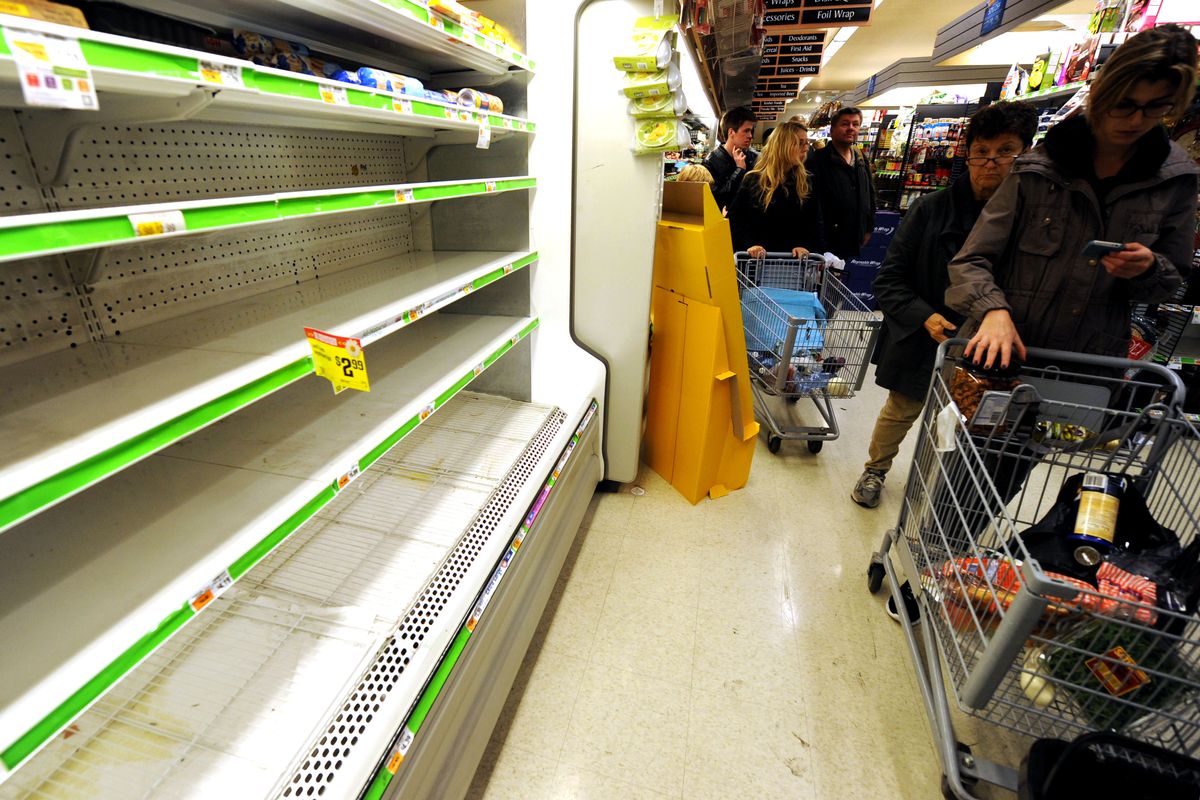NYC braces for wall of water from superstorm

NEW YORK (AP) — After days of seeming to take a looming superstorm in stride, New Yorkers gathered supplies or tried to get out of the way as forecasters warned that a wall of water could hit the nation’s largest city.
Facing a seawater surge of anywhere from 6 to 11 feet from Hurricane Sandy, the city shut down its mass transit system, closed its schools and ordered hundreds of thousands of people to flee their homes Sunday. Some New Yorkers packed grocery stores for water and food and scrambled to get out of flood zones, while others insisted they weren’t going anywhere.
Clutching a white pillow in her left hand and two computers in another, Alyssa Marks rushed to get to the subway before it stopped running Sunday evening. She’d gotten cash but had no time to get toiletries and water.
“I’m nervous, but I’m also excited,” she said as she left her apartment in a lower Manhattan evacuation zone for a friend’s place on higher ground.
Ralph Gorham watched the sea get rough, but he planned to weather the storm at the Red Hook Lobster Pound, the seafood business he co-owns in a low-lying part of Brooklyn.
“I’m not leaving. My house is here. My business is here,” he said. “When the bell tolls, you live with it.”
Warnings about the superstorm — a predicted combination of Sandy, a wintry system moving in from the West and cold air streaming down from the Arctic — took on a much more ominous tone Sunday.
The National Oceanic and Atmospheric Administration’s environmental protection chief, Louis Uccellini, called the projected storm surge “the worst-case scenario” for New York City, Long Island and northern New Jersey.
It threatened to swamp parts of lower Manhattan, flood subway tunnels and knock out the underground network of power, phone and high-speed Internet lines that are the lifeblood of America’s financial capital.
The New York Stock Exchange and other U.S. financial markets are shutting down Monday as Hurricane Sandy bears down on the nation’s largest city.
The NYSE’s parent company said late Sunday that the shutdown might be extended through Tuesday “pending confirmation,” according to exchange operator NYSE Euronext.
“If you don’t evacuate, you’re not just putting your own life in danger — you are also endangering the lives of our first responders who may have to come in and rescue you,” Mayor Michael Bloomberg said at a news conference Sunday as he announced a mandatory evacuation affecting 375,000 people in low-lying areas from the beaches of Queens to the glassy high-rises of Battery Park City. “This is a serious and dangerous storm.”
Gov. Andrew Cuomo deployed National Guard troops to the city and Long Island. Consolidated Edison weighed the possibility of shutting down power in parts of lower Manhattan to protect equipment. Broadway shows were canceled for Sunday and Monday. One small hospital was being evacuated, while several others were moving patients to higher floors.
America’s biggest public school system, which serves 1.1 million students, was ordered closed Monday, while many of the schools opened Sunday as emergency shelters.
It marked the second time in 14 months that New York City has faced a scenario forecasters have long feared: a big hurricane hitting the city or a bit south, such that the cyclone’s counterclockwise winds drive water into miles of densely populated shoreline.
Hurricane Irene ultimately came ashore as a tropical storm in Coney Island, with a 4-foot storm surge that washed over parts of the southern tip of Manhattan but didn’t wreak the havoc that officials had feared, although it caused tremendous damage elsewhere. Some experts have said that a surge 3 feet higher could have caused huge damage.
Bloomberg announced evacuations around 11:30 a.m., telling people to be out just 7½ hours later. By 7 p.m., subways and buses were shut down, leaving more than 5 million mostly carless daily riders on their own to get to higher ground.
For those who refused to leave, they mayor had a message.
“They won’t be arrested. But I would argue they are being very selfish,” Bloomberg said, noting rescue crews will still try to help them if they are flooded. “We aren’t going to leave them to die. We are going to save them.”
___
Associated Press writers Verena Dobnik and Deepti Hajela in New York and Seth Borenstein in Kensington, Md., contributed to this report.